check engine light SKODA SUPERB 2013 2.G / (B6/3T) Owner's Guide
[x] Cancel search | Manufacturer: SKODA, Model Year: 2013, Model line: SUPERB, Model: SKODA SUPERB 2013 2.G / (B6/3T)Pages: 274, PDF Size: 17.31 MB
Page 217 of 274
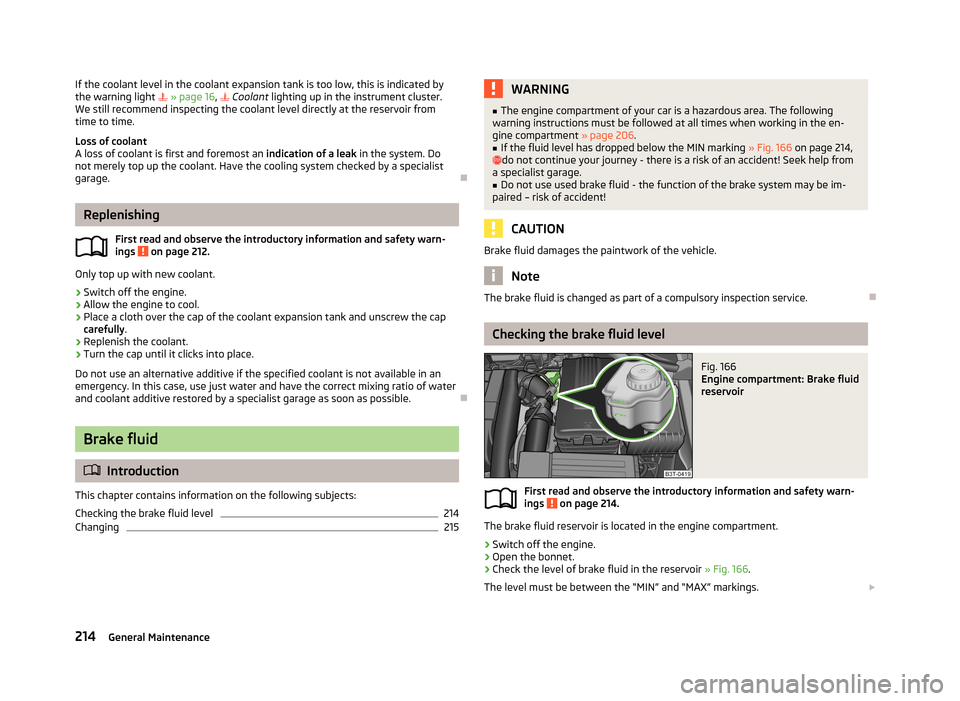
If the coolant level in the coolant expansion tank is too low, this is indicated by
the warning light » page 16 , Coolant lighting up in the instrument cluster.
We still recommend inspecting the coolant level directly at the reservoir from
time to time.
Loss of coolant
A loss of coolant is first and foremost an indication of a leak in the system. Do
not merely top up the coolant. Have the cooling system checked by a specialist
garage.
Replenishing
First read and observe the introductory information and safety warn-
ings
on page 212.
Only top up with new coolant.
›
Switch off the engine.
›
Allow the engine to cool.
›
Place a cloth over the cap of the coolant expansion tank and unscrew the cap carefully .
›
Replenish the coolant.
›
Turn the cap until it clicks into place.
Do not use an alternative additive if the specified coolant is not available in an emergency. In this case, use just water and have the correct mixing ratio of waterand coolant additive restored by a specialist garage as soon as possible.
Brake fluid
Introduction
This chapter contains information on the following subjects:
Checking the brake fluid level
214
Changing
215WARNING■ The engine compartment of your car is a hazardous area. The following
warning instructions must be followed at all times when working in the en-
gine compartment » page 206.■
If the fluid level has dropped below the MIN marking » Fig. 166 on page 214,
do not continue your journey - there is a risk of an accident! Seek help from
a specialist garage.
■
Do not use used brake fluid - the function of the brake system may be im-
paired – risk of accident!
CAUTION
Brake fluid damages the paintwork of the vehicle.
Note
The brake fluid is changed as part of a compulsory inspection service.
Checking the brake fluid level
Fig. 166
Engine compartment: Brake fluid
reservoir
First read and observe the introductory information and safety warn-
ings on page 214.
The brake fluid reservoir is located in the engine compartment.
›
Switch off the engine.
›
Open the bonnet.
›
Check the level of brake fluid in the reservoir » Fig. 166.
The level must be between the “MIN” and “MAX” markings.
214General Maintenance
Page 220 of 274

When working on the battery, the edge of the polyester battery cover1 » Fig. 167 is inserted between the battery and the side wall of the battery cov-
er.
Battery in the engine compartment›
Open the battery cover in the direction of the arrow
1
or press the interlock on
the side of the battery cover in the direction of the arrow
2
» Fig. 167 , fold the
cover up and remove.
The battery cover is installed in reverse order.
Battery in the boot
The battery is located in the left side compartment with the symbol » Fig. 90
on page 90.
Checking the battery electrolyte level
Fig. 168
Vehicle battery: Electrolyte level
indicator
First read and observe the introductory information and safety warn-
ings on page 215.
On vehicles with a vehicle battery fitted with a colour indicator, the so-called
magic eye » Fig. 168, the electrolyte level can be determined by looking at the
change in colour.
Air bubbles can influence the colour of the indicator. For this reason carefully
knock on the indicator before carrying out the check.
› Black colour - electrolyte level is correct.
› Colourless or light yellow colour - electrolyte level too low, the battery must be
replaced.
Vehicles with a START-STOP system are fitted with a battery control unit for checking the energy level for the recurring engine start.
We recommend that you have the acid level checked regularly by a specialist ga-rage, especially in the following cases.
› High external temperatures.
› Longer day trips.
› After each charge.
Winter time
The vehicle battery only has a proportion of the starting power in lower tempera-
tures. A discharged vehicle battery may already freeze at temperatures just be-
low 0 °C .
We therefore recommend that you have the battery checked and, if necessary, re-
charged by a specialist garage before the start of the winter.
CAUTION
For technical reasons, on vehicles with the description “AGM”, the electrolyte lev-
el cannot be checked.
Note
The battery acid level is also checked regularly by a specialist garage as part of
the inspection service.
Charging
First read and observe the introductory information and safety warn-ings
on page 215.
A properly charged vehicle battery is essential for reliably starting the engine.
›
Switch off the ignition and all of the electrical components.
›
Only when performing a “quick-charge”, disconnect both battery cables (first
“negative”, then “positive”).
›
Attach the terminal clamps of the charger to the battery terminals (red = “posi-
tive”, black = “negative”).
›
Plug the mains cable of the charger into the power socket and switch on the
device.
›
After charging has been successful: Switch off the charger and remove themains cable from the power socket.
›
Only then disconnect the charger's terminal clamps.
›
Reconnect the cables to the battery (first “positive”, then “negative”).
217Inspecting and replenishing
Page 233 of 274
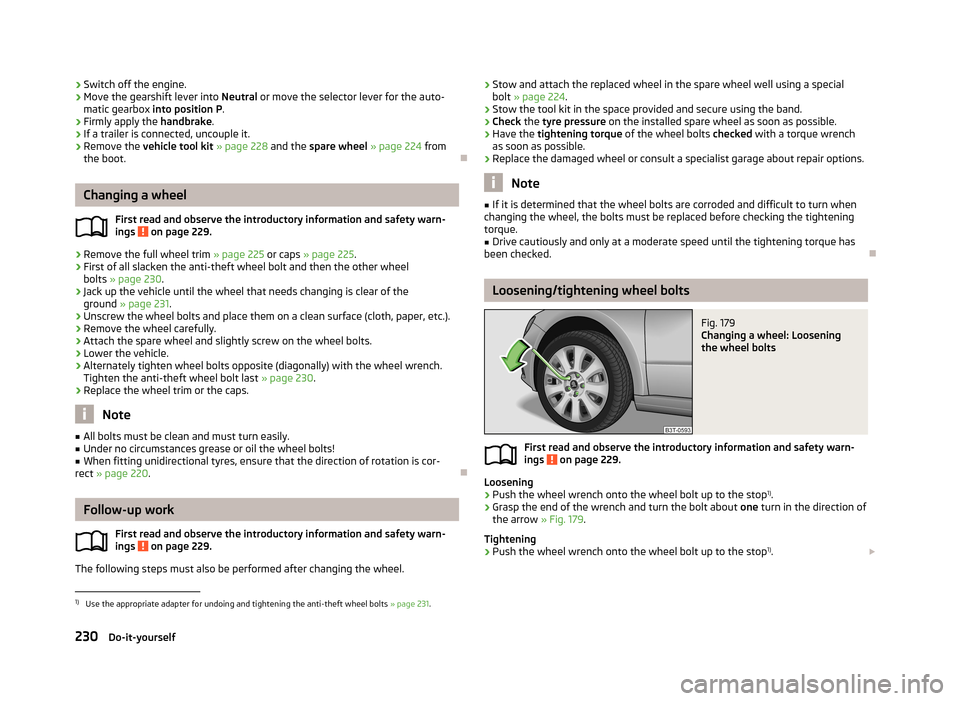
›Switch off the engine.›Move the gearshift lever into
Neutral or move the selector lever for the auto-
matic gearbox into position P .›
Firmly apply the handbrake.
›
If a trailer is connected, uncouple it.
›
Remove the vehicle tool kit » page 228 and the spare wheel » page 224 from
the boot.
Changing a wheel
First read and observe the introductory information and safety warn-
ings
on page 229.
›
Remove the full wheel trim » page 225 or caps » page 225 .
›
First of all slacken the anti-theft wheel bolt and then the other wheel
bolts » page 230 .
›
Jack up the vehicle until the wheel that needs changing is clear of the
ground » page 231 .
›
Unscrew the wheel bolts and place them on a clean surface (cloth, paper, etc.).
›
Remove the wheel carefully.
›
Attach the spare wheel and slightly screw on the wheel bolts.
›
Lower the vehicle.
›
Alternately tighten wheel bolts opposite (diagonally) with the wheel wrench.
Tighten the anti-theft wheel bolt last » page 230.
›
Replace the wheel trim or the caps.
Note
■
All bolts must be clean and must turn easily.■Under no circumstances grease or oil the wheel bolts!■
When fitting unidirectional tyres, ensure that the direction of rotation is cor-
rect » page 220 .
Follow-up work
First read and observe the introductory information and safety warn-
ings
on page 229.
The following steps must also be performed after changing the wheel.
› Stow and attach the replaced wheel in the spare wheel well using a special
bolt » page 224 .›
Stow the tool kit in the space provided and secure using the band.
›
Check the tyre pressure on the installed spare wheel as soon as possible.
›
Have the tightening torque of the wheel bolts checked with a torque wrench
as soon as possible.
›
Replace the damaged wheel or consult a specialist garage about repair options.
Note
■ If it is determined that the wheel bolts are corroded and difficult to turn when
changing the wheel, the bolts must be replaced before checking the tightening
torque.■
Drive cautiously and only at a moderate speed until the tightening torque has
been checked.
Loosening/tightening wheel bolts
Fig. 179
Changing a wheel: Loosening
the wheel bolts
First read and observe the introductory information and safety warn- ings on page 229.
Loosening
›
Push the wheel wrench onto the wheel bolt up to the stop 1)
.
›
Grasp the end of the wrench and turn the bolt about one turn in the direction of
the arrow » Fig. 179.
Tightening
›
Push the wheel wrench onto the wheel bolt up to the stop 1)
.
1)
Use the appropriate adapter for undoing and tightening the anti-theft wheel bolts
» page 231.
230Do-it-yourself
Page 236 of 274

Breakdown kitFig. 183
Components of the breakdown kit
First read and observe the introductory information and safety warn-
ings
on page 232.
The kit is located in a box under the floor covering in the luggage compartment.
Components of the breakdown kit Valve remover
Sticker with speed designation “max. 80 km/h”/“max. 50 mph”
Inflation hose with plug
Air compressor
Tyre inflation hose
Tyre inflation pressure indicator
Air release valve
ON and OFF switch
12 volt cable connector
Tyre inflator bottle with sealing agent
Replacement valve core
The valve remover
1
has a slot at its lower end which fits into the valve core.
This is the only way in which you can remove and re-install the valve core from
the tyre valve. The same also applies to the replacement valve core
11
.
1234567891011Preparations for using the breakdown kit
First read and observe the introductory information and safety warn-
ings
on page 232.
The following preparatory work must be carried out before using the breakdown
kit.
›
Park the vehicle as far away as possible from the flow of traffic. Park on as flat and firm a surface as possible.
›
If you are in flowing traffic, switch on the hazard warning light system and setup the warning triangle at the prescribed distance! The national legal require-
ments must be observed.
›
Let all of the occupants get out. While changing a tyre, the occupants of the
vehicle should not stand on the road (instead they should remain behind a crash
barrier).
›
Switch off the engine and move the gearshift lever into Neutral or move the se-
lector lever on the automatic gearbox into position P.
›
Firmly apply the handbrake.
›
Check that you can carry out the repairs with the breakdown kit » page 232.
›
If a trailer is connected, uncouple it.
›
Remove the breakdown kit from the boot.
›
Stick the sticker
2
» Fig. 183 on page 233 on the dash panel in view of the driv-
er.
›
Do not remove the foreign body, e.g. screw or nail, from the tyre.
›
Unscrew the valve cap.
›
Use the valve remover
1
to unscrew the valve core and place it on a clean sur-
face (rag, paper, etc.).
Sealing and inflating the tyre
First read and observe the introductory information and safety warn-
ings
on page 232.
Sealing
›
Forcefully shake the tyre inflator bottle
10
» Fig. 183 on page 233 several times.
›
Firmly screw the inflation hose
3
onto the tyre inflator bottle
10
in a clockwise
direction. The film on the cap is pierced automatically.
›
Remove the plug from the inflation hose
3
and plug the open end fully onto
the tyre valve.
›
Hold the bottle
10
with the bottom facing upwards and fill all of the sealing
agent from the tyre inflator bottle into the tyre.
233Emergency equipment and self-help
Page 237 of 274
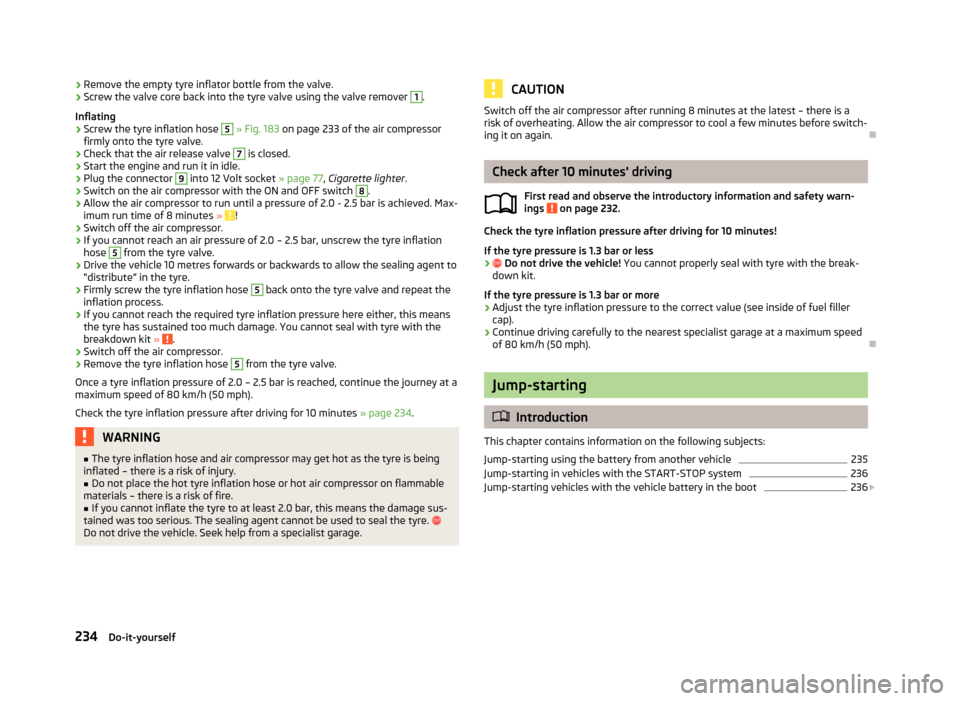
›Remove the empty tyre inflator bottle from the valve.›Screw the valve core back into the tyre valve using the valve remover 1.
Inflating›
Screw the tyre inflation hose
5
» Fig. 183 on page 233 of the air compressor
firmly onto the tyre valve.
›
Check that the air release valve
7
is closed.
›
Start the engine and run it in idle.
›
Plug the connector
9
into 12 Volt socket » page 77, Cigarette lighter .
›
Switch on the air compressor with the ON and OFF switch
8
.
›
Allow the air compressor to run until a pressure of 2.0 - 2.5 bar is achieved. Max-
imum run time of 8 minutes » !
›
Switch off the air compressor.
›
If you cannot reach an air pressure of 2.0 – 2.5 bar, unscrew the tyre inflation
hose
5
from the tyre valve.
›
Drive the vehicle 10 metres forwards or backwards to allow the sealing agent to
“distribute” in the tyre.
›
Firmly screw the tyre inflation hose
5
back onto the tyre valve and repeat the
inflation process.
›
If you cannot reach the required tyre inflation pressure here either, this means
the tyre has sustained too much damage. You cannot seal with tyre with the breakdown kit »
.
›
Switch off the air compressor.
›
Remove the tyre inflation hose
5
from the tyre valve.
Once a tyre inflation pressure of 2.0 – 2.5 bar is reached, continue the journey at a
maximum speed of 80 km/h (50 mph).
Check the tyre inflation pressure after driving for 10 minutes » page 234.
WARNING■
The tyre inflation hose and air compressor may get hot as the tyre is being
inflated – there is a risk of injury.■
Do not place the hot tyre inflation hose or hot air compressor on flammable
materials – there is a risk of fire.
■
If you cannot inflate the tyre to at least 2.0 bar, this means the damage sus-
tained was too serious. The sealing agent cannot be used to seal the tyre.
Do not drive the vehicle. Seek help from a specialist garage.
CAUTIONSwitch off the air compressor after running 8 minutes at the latest – there is a
risk of overheating. Allow the air compressor to cool a few minutes before switch- ing it on again.
Check after 10 minutes' driving
First read and observe the introductory information and safety warn-ings
on page 232.
Check the tyre inflation pressure after driving for 10 minutes!
If the tyre pressure is 1.3 bar or less
›
Do not drive the vehicle! You cannot properly seal with tyre with the break-
down kit.
If the tyre pressure is 1.3 bar or more
›
Adjust the tyre inflation pressure to the correct value (see inside of fuel filler cap).
›
Continue driving carefully to the nearest specialist garage at a maximum speed
of 80 km/h (50 mph).
Jump-starting
Introduction
This chapter contains information on the following subjects:
Jump-starting using the battery from another vehicle
235
Jump-starting in vehicles with the START-STOP system
236
Jump-starting vehicles with the vehicle battery in the boot
236
234Do-it-yourself
Page 247 of 274

Fuses and light bulbs
Fuses
Introduction
This chapter contains information on the following subjects:
Fuses in the dash panel
244
Fuses in the engine compartment
246
Assignment of fuses in the engine compartment
246
Individual electrical circuits are protected by fuses.
Switch off the ignition and the corresponding power consuming device before re-
placing a fuse.
Find out which fuse belongs to the component that is not operating » page 244,
Fuses in the dash panel or » page 246 , Assignment of fuses in the engine com-
partment .
Electrically adjustable seats are protected by automatic circuit breakers, which
switch on again automatically after a few seconds after the overload has been
eliminated.
Fuse colourMaximum amperagelight brown5dark brown7.5red10blue15yellow20white25green30orange40red50WARNINGAlways read and observe the warnings before completing any work in the en-
gine compartment » page 206.CAUTION■
“Never repair” fuses or replace them with a fuse of a higher amperage – risk of
fire! This may also cause damage at another part of the electrical system.■
If a newly inserted fuse blows again after a short time, have the electrical sys-
tem checked as quickly as possible by a specialist garage.
■
A blown fuses is recognisable by the molten metal strip. Replace the faulty fuse
with a new one of the same amperage.
Note
■
We recommend always carrying replacement fuses in the vehicle. A box of re-
placement fuses can be purchased from ŠKODA Original Accessories.■
There can be several power consuming devices for one fuse.
■
There can be several consumer devices for one fuse, depending on the vehicle's
equipment.
■
Multiple fuses may exist for a single power consuming device.
■
Multiple power consuming devices can share a single fuse.
Fuses in the dash panel
Fig. 198
Cover of the fuse box in the control panel / fuses
First read and observe the introductory information and safety warn-
ings
on page 244.
The fuses are located on the left side of the dash panel behind a cover.
Replacing fuses
›
Remove the cover of the fuse box » Fig. 198.
›
Remove the plastic clip from the holder in the cover of the fuse box in the panel.
244Do-it-yourself
Page 251 of 274
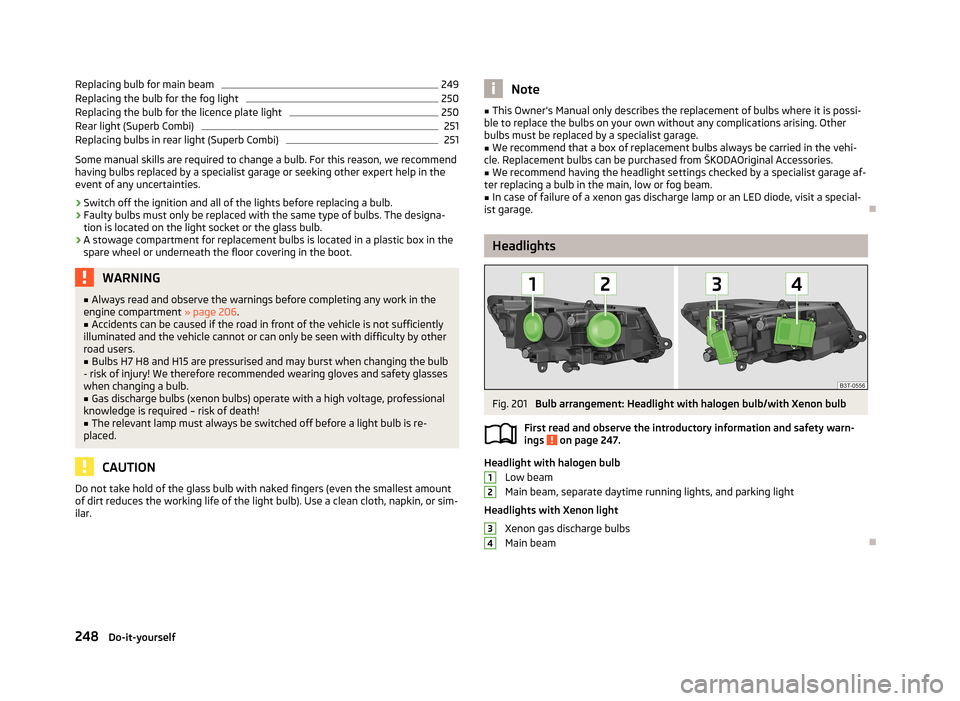
Replacing bulb for main beam249Replacing the bulb for the fog light250
Replacing the bulb for the licence plate light
250
Rear light (Superb Combi)
251
Replacing bulbs in rear light (Superb Combi)
251
Some manual skills are required to change a bulb. For this reason, we recommend
having bulbs replaced by a specialist garage or seeking other expert help in the
event of any uncertainties.
› Switch off the ignition and all of the lights before replacing a bulb.
› Faulty bulbs must only be replaced with the same type of bulbs. The designa-
tion is located on the light socket or the glass bulb.
› A stowage compartment for replacement bulbs is located in a plastic box in the
spare wheel or underneath the floor covering in the boot.
WARNING■ Always read and observe the warnings before completing any work in the
engine compartment » page 206.■
Accidents can be caused if the road in front of the vehicle is not sufficiently
illuminated and the vehicle cannot or can only be seen with difficulty by other
road users.
■
Bulbs H7 H8 and H15 are pressurised and may burst when changing the bulb
- risk of injury! We therefore recommended wearing gloves and safety glasses when changing a bulb.
■
Gas discharge bulbs (xenon bulbs) operate with a high voltage, professional
knowledge is required – risk of death!
■
The relevant lamp must always be switched off before a light bulb is re-
placed.
CAUTION
Do not take hold of the glass bulb with naked fingers (even the smallest amount of dirt reduces the working life of the light bulb). Use a clean cloth, napkin, or sim-
ilar.Note■ This Owner's Manual only describes the replacement of bulbs where it is possi-
ble to replace the bulbs on your own without any complications arising. Other bulbs must be replaced by a specialist garage.■
We recommend that a box of replacement bulbs always be carried in the vehi-
cle. Replacement bulbs can be purchased from ŠKODAOriginal Accessories.
■
We recommend having the headlight settings checked by a specialist garage af-
ter replacing a bulb in the main, low or fog beam.
■
In case of failure of a xenon gas discharge lamp or an LED diode, visit a special-
ist garage.
Headlights
Fig. 201
Bulb arrangement: Headlight with halogen bulb/with Xenon bulb
First read and observe the introductory information and safety warn- ings
on page 247.
Headlight with halogen bulb
Low beam
Main beam, separate daytime running lights, and parking light
Headlights with Xenon light Xenon gas discharge bulbs
Main beam
1234248Do-it-yourself
Page 264 of 274
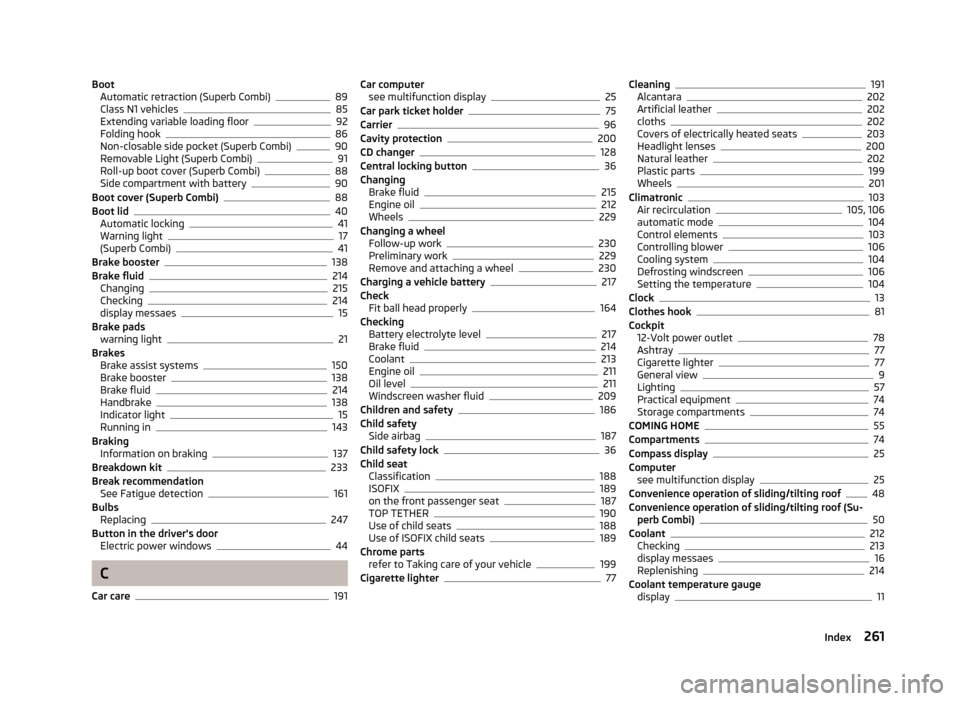
BootAutomatic retraction (Superb Combi)89
Class N1 vehicles85
Extending variable loading floor92
Folding hook86
Non-closable side pocket (Superb Combi)90
Removable Light (Superb Combi)91
Roll-up boot cover (Superb Combi)88
Side compartment with battery90
Boot cover (Superb Combi)88
Boot lid40
Automatic locking41
Warning light17
(Superb Combi)41
Brake booster138
Brake fluid214
Changing215
Checking214
display messaes15
Brake pads warning light
21
Brakes Brake assist systems
150
Brake booster138
Brake fluid214
Handbrake138
Indicator light15
Running in143
Braking Information on braking
137
Breakdown kit233
Break recommendation See Fatigue detection
161
Bulbs Replacing
247
Button in the driver's door Electric power windows
44
C
Car care
191
Car computer see multifunction display25
Car park ticket holder75
Carrier96
Cavity protection200
CD changer128
Central locking button36
Changing Brake fluid
215
Engine oil212
Wheels229
Changing a wheel Follow-up work
230
Preliminary work229
Remove and attaching a wheel230
Charging a vehicle battery217
Check Fit ball head properly
164
Checking Battery electrolyte level
217
Brake fluid214
Coolant213
Engine oil211
Oil level211
Windscreen washer fluid209
Children and safety186
Child safety Side airbag
187
Child safety lock36
Child seat Classification
188
ISOFIX189
on the front passenger seat187
TOP TETHER190
Use of child seats188
Use of ISOFIX child seats189
Chrome parts refer to Taking care of your vehicle
199
Cigarette lighter77
Cleaning191
Alcantara202
Artificial leather202
cloths202
Covers of electrically heated seats203
Headlight lenses200
Natural leather202
Plastic parts199
Wheels201
Climatronic103
Air recirculation105, 106
automatic mode104
Control elements103
Controlling blower106
Cooling system104
Defrosting windscreen106
Setting the temperature104
Clock13
Clothes hook81
Cockpit 12-Volt power outlet
78
Ashtray77
Cigarette lighter77
General view9
Lighting57
Practical equipment74
Storage compartments74
COMING HOME55
Compartments74
Compass display25
Computer see multifunction display
25
Convenience operation of sliding/tilting roof48
Convenience operation of sliding/tilting roof (Su- perb Combi)
50
Coolant212
Checking213
display messaes16
Replenishing214
Coolant temperature gauge display
11
261Index
Page 265 of 274
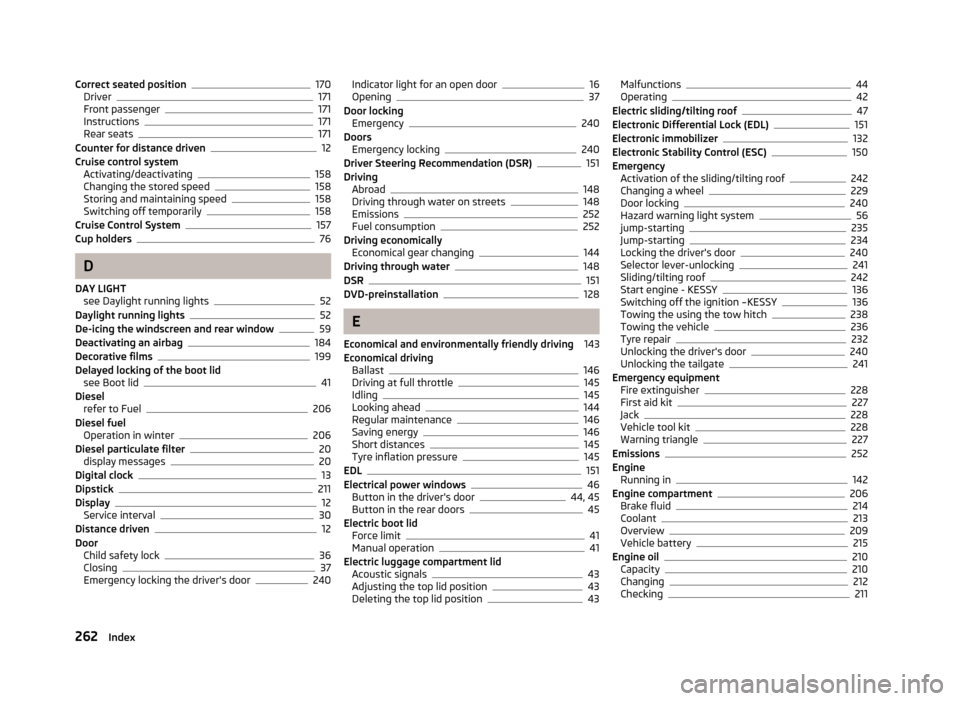
Correct seated position170
Driver171
Front passenger171
Instructions171
Rear seats171
Counter for distance driven12
Cruise control system Activating/deactivating
158
Changing the stored speed158
Storing and maintaining speed158
Switching off temporarily158
Cruise Control System157
Cup holders76
D
DAY LIGHT see Daylight running lights
52
Daylight running lights52
De-icing the windscreen and rear window59
Deactivating an airbag184
Decorative films199
Delayed locking of the boot lid see Boot lid
41
Diesel refer to Fuel
206
Diesel fuel Operation in winter
206
Diesel particulate filter20
display messages20
Digital clock13
Dipstick211
Display12
Service interval30
Distance driven12
Door Child safety lock
36
Closing37
Emergency locking the driver's door240
Indicator light for an open door16
Opening37
Door locking Emergency
240
Doors Emergency locking
240
Driver Steering Recommendation (DSR)151
Driving Abroad
148
Driving through water on streets148
Emissions252
Fuel consumption252
Driving economically Economical gear changing
144
Driving through water148
DSR151
DVD-preinstallation128
E
Economical and environmentally friendly driving 143
Economical driving Ballast
146
Driving at full throttle145
Idling145
Looking ahead144
Regular maintenance146
Saving energy146
Short distances145
Tyre inflation pressure145
EDL151
Electrical power windows46
Button in the driver's door44, 45
Button in the rear doors45
Electric boot lid Force limit
41
Manual operation41
Electric luggage compartment lid Acoustic signals
43
Adjusting the top lid position43
Deleting the top lid position43
Malfunctions44
Operating42
Electric sliding/tilting roof47
Electronic Differential Lock (EDL)151
Electronic immobilizer132
Electronic Stability Control (ESC)150
Emergency Activation of the sliding/tilting roof
242
Changing a wheel229
Door locking240
Hazard warning light system56
jump-starting235
Jump-starting234
Locking the driver's door240
Selector lever-unlocking241
Sliding/tilting roof242
Start engine - KESSY136
Switching off the ignition –KESSY136
Towing the using the tow hitch238
Towing the vehicle236
Tyre repair232
Unlocking the driver's door240
Unlocking the tailgate241
Emergency equipment Fire extinguisher
228
First aid kit227
Jack228
Vehicle tool kit228
Warning triangle227
Emissions252
Engine Running in
142
Engine compartment206
Brake fluid214
Coolant213
Overview209
Vehicle battery215
Engine oil210
Capacity210
Changing212
Checking211
262Index
Page 270 of 274

Storage compartments74
Storage compartment under the passenger seat81
Storage pockets on the front seats82
Storing skis83
Sun screen60
Sun screen in the rear doors61
Sun visors60
Switch see Ignition
132
Switching lights on and off51
Switching off the engine see KESSY
136
Switching off the ignition see KESSY
136
Switching on the ignition see KESSY
135
T
Tailgate TwinDoor
40
Taking care of the vehicle Natural leather
202
Seat belts203
Taking care of your vehicle Automatic car wash system
197
Cavity protection200
Chrome parts199
Cleaning the wheels201
Decorative films199
Door lock cylinders200
Headlight lenses200
High-pressure cleaner197
Plastic parts199
Polishing the paintwork198
Rubber seals199
Taking care of the interior201
Taking care of your vehicle exterior198
Washing196
Washing by hand197
Wash system197
Wax treatment198
Taking care of your vehicles Fabric covers
203
TCS Operation
151
Technical data252
Telephone113, 115
Tilting roof see Electric sliding/tilting roof
47
Tiptronic141
Tools228
TOP TETHER190
Towing236
Towing a trailer162
Towing device Description
162
Drawbar load162
Use and care165
Towing eye Front
237
Rear238
Towing protection39
Traction Control System (TCS)151
Trailer162, 165
13-pin power socket166
driving with a trailer166
Loading165
Safety eye166
Trailer stabilisation167
Transport Luggage compartment
84
Roof rack system96
Transporting children safely186
Turn signal53
Twindoor see boot lid
40
Two-way radio systems110
Type plate252
Tyre load-bearing capacity See Wheels222
Tyre pressure monitor Setting
223
Tyre repair Check pressure
234
Preparations233
Sealing and inflating the tyre233
Tyres220
Inflation pressure221
New222
See Wheels222
Sizes221
Tyre wear indicator221
U
Umbrella Tray
82
Underbody protection201
Unleaded petrol148
Unlock Remote control
33
Vehicle key33
Unlocking Individual settings
35
KESSY34
Unlocking and locking32
Useful equipment Ashtray
77
Car park ticket holder75
Cigarette lighter77
Clothes hook81
Cup holders76
Glasses storage box80
Removable ski bag84
Seat backrest with long-cargo channel83
Storage compartment in the front centre console 76
Storage compartment on the driver's side
75
Storage compartments in the doors75
Using the information system23
267Index